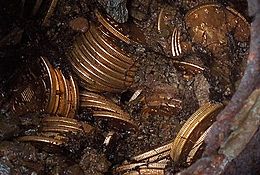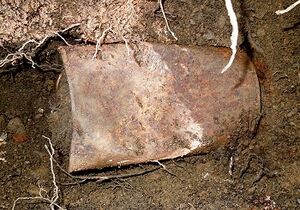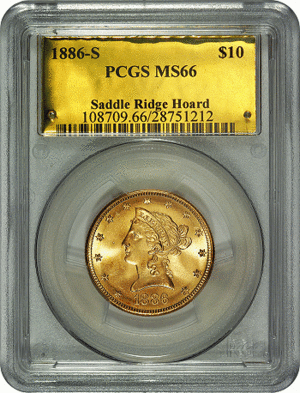Saddle Ridge Hoard facts for kids
Quick facts for kids Saddle Ridge Hoard |
|
|---|---|

Gold coins in situ
|
|
| Material | Gold coins |
| Size | 1,427 coins |
| Created | 1847 to 1894 |
| Discovered | Gold Country, Sierra Nevada, California in February 2013 |
| Present location | Tiburon, California |
Imagine finding a huge treasure chest! That's what happened in 2013 when a couple in California found the Saddle Ridge Hoard. This amazing discovery was a hidden collection of 1,427 gold coins. They were found in the Gold Country area of the Sierra Nevada mountains.
The coins were made between 1847 and 1894. Their original value was about $27,980. But experts said the collection was actually worth around $10 million! This makes it the biggest discovery of buried gold coins ever found in the United States.
Contents
How the Treasure Was Found
The Saddle Ridge Hoard was found in February 2013. A couple, known only as John and Mary, discovered it on their private land in California's Gold Country. They want to stay anonymous to keep treasure hunters from coming onto their property.
The couple was walking their dog when they saw something unusual. A rusty metal can was sticking out of the ground. They had walked this path many times before, but never noticed it.
Before finding the can, they had noticed other strange things. There was an old, empty can hanging from a tree. The tree had grown around it over time. They also saw an odd-shaped rock nearby. They called it "Saddle Ridge." After finding the gold, they realized these might have been markers. The original owners probably left them to help find the spot. The treasure was found about ten steps between the strange rock and the direction of the North Star.
When Mary saw the can, John tried to pick it up. It was stuck and very heavy. They thought it might be filled with old paint. As they carried it home, the lid cracked open. They saw the edge of a gold coin!
They went back to the spot with tools. They found another rusty can about a foot away. It also held many coins. They kept digging and even used a metal detector. In total, they found eight cans filled with 1,427 gold coins.
After their amazing find, John and Mary hid the coins. They put them in an old ice chest and buried it under a pile of wood. Later, they contacted a company called Kagin's, which helps with rare coins.
Checking and Valuing the Coins
A coin expert named David J. McCarthy from Kagin's looked at the coins first. He realized how important this discovery was. Before this, the biggest buried gold find in the U.S. was in Jackson, Tennessee, in 1985. That find was worth about $1 million. The Saddle Ridge Hoard is worth much more.
Kagin's then sent the coins to the Professional Coin Grading Service (PCGS). This company independently checks and grades coins. PCGS said many coins were in perfect, uncirculated condition. Some are so rare they could be worth about $1 million each!
The collection includes some very special coins:
- An 1866-S $20 coin without a motto, valued at about $1 million.
- An 1866-S $20 coin with a motto, which is the best known of its kind.
- An 1877-S $20 coin, tied for the best known of its kind.
- Several 1888-S, 1889-S, and 1894-S $20 coins, also tied for the best known of their kind.
What Happened to the Coins?
Most of the coins were sold through Amazon.com's collectibles store. This was the first time such a large coin collection was sold on Amazon. John and Mary used the money to pay off their debts. They also gave some to local charities. They kept a few coins for their family as special keepsakes.
Who Buried the Treasure?
Many people wondered who might have buried the coins. One idea was that they were stolen from the San Francisco Mint in 1901. However, experts from Kagin's and the U.S. Mint said this was unlikely. The coins in the hoard were too varied in type and condition to be from that theft. The U.S. Mint confirmed they had no information linking the hoard to any thefts.
Other ideas included famous outlaws like Jesse James or Black Bart. Some even thought it was gold from a secret group called the Knights of the Golden Circle.
The most likely idea is that an unknown person buried the coins. They probably didn't trust banks and wanted to keep their wealth safe. Even though the couple who found the coins stayed anonymous, some people tried to claim the gold. They said it belonged to their relatives. But none of these claims were successful.
Images for kids
-
Gold coins in situ






